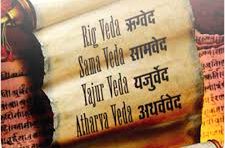HINDUISM – A BIRD’S EYE VIEW (Part-II)
Dr. Suresh Kurl
The Indian history of speculative thought has its beginning in the Rig Veda, a treasure of cosmic mysteries: the daily drama of the sunrise, sunset, wind and rain, of light and darkness, of calm and storm.
Then was not non-existent, nor existent: there was no realm of air, no sky beyond it.
What covered in, and where? And what gave shelter? Was water there, unfathomed depth of water?
Death was not then, nor was there aught immortal: no sign was there, the day’s and night’s divider.
That one thing, breathless, breathed by its own nature: apart from it was nothing whatsoever.
Rig Veda; X: 129
Consisting of 1028 hymns, Rig Veda is supposedly the oldest Veda. Each hymn is a richa, a couplet or a mantra. The origin of “richa” is from the Sanskrit-root, rich, to praise. As such, the Rig Veda is a Veda of praises. These hymns are said to have been compiled by the Sage Vyasa around 1,500 B.C., and channelled by seven Risis (seers) named, Atri, Kanwa, Vashistha, Vishwamitra, Jamadagni, Gotama, and Bharadwaja.
Rig Veda defines God is the Only Truth, the Only Being (Ekam Sad), as the monotheistic Judaism, Christianity, Islam and Sikhism define Him. However, the Rig Veda does not pull down the shutters on God’s Polytheistic aspect. It recognises Him both as monotheistic and polytheistic — Vipra bhahudha vadanti (Rig Veda 1.164.46.). It speaks of the deities such as, the Brahma (Creator), Vishnu (Preserver), and Shiva (Destroyer of the Universe) and of Varuna, Indra, Agni, Soma, and Usha etc. Not only that, it describes female deities as well such as, Aranyani (the goddess of the forest) and Saraswati (the goddess of knowledge) etc. The following is a brief description of some of these deities.
Vishnu: “I will declare the mighty deed of Vishnu, of him who measured out the earthly region,
Who propped the highest place of congregation, Trice setting down his footsteps, widely striding.” Rig Veda 1:154
Rudra: “May thy bright arrow which, shot down by thee from heaven, flieth upon the earth, pass us uninjured by. Thou, very gracious God, hast thousand medicines: Inflict no evil on our sons or progeny”‘ Rig Veda; VII: 46
Varuna is the most honoured Vedic deity. He is the guardian of the cosmic order (rita), who is responsible for maintaining the physical and moral order, such as, for the sun to rise and set at his command.
“Sing forth a hymn sublime and solemn, grateful and glorious Varuna, imperial ruler;” Rig Veda; V: 85
Indra is the most regarded deity of the Aryans. He was the god of battles. He was the one the warriors rushed for protection; (Rig Veda: IV: 24). His name was used as a battle cry, similar to the modern day “Har-Har-Mahadev,” or “Allah-Hu-Akbar.”
There are numerous myths in the Rig Veda recounting Indra’s deeds. One of them is about the slaying of the demon Vritra, who had enclosed the waters (rain) and the sun causing a cosmic chaos, which ended only when Indra killed Vritra and freed the waters and the sun, the two basic life sustaining essentials.
Agni is recognised in three forms: terrestrial (fire), atmospheric (lightening), and celestial as the sun. Agni is second to Indra in prominence as he is the priest of the gods and also the priest of the earthly Vedic priests. Agni acts as a liaison between us and the heavenly gods. He delivers our oblations to them and our departed ancestors in the heaven.
“O Agni, I adore Thee, O priest. O divine minister.
You officiate at the divine Sacrifice, You invoke and summon.
You bestow the divine wealth upon us.” Rig Veda; I.I
Saraswati: “I sing a lofty song for she is mightiest, most divine of streams, Saraswati will I exalt
with hymns and lauds…” Rig Veda; VII: 96
The Gayatri mantra is the most famous Vedic chant expressing our praise for the god Sun. Through this chant we pour out our happiness, when it rises:
Om bhoor bhu vah svah tat savitur varenyam, bhargo devasya dhi mahi, dhiyo yo nah pracho dayat. Rig Veda; Mandala 3.62.10.
“Let us adore the supremacy of that divine sun, the god-head, who illuminates all, who recreates all, from whom all proceeds, to whom all must return, whom we invoke to direct our understandings aright in our progress toward his holy seat.” —Sir William Jones (1807)
You notice that the Rig Veda is full of life, its obligations, praises and prayers.
Daana: The importance of giving.
The riches of the liberal never waste away.
While he, who will not give, finds none to comfort him.
–Rig Veda; X: 117
Death:
The gods have not ordained hunger to be our death.
Even to the well-fed man comes death in varied shapes.
Funeral Rites: Regarding the last rites (Antyeshti), the Rig Veda talks about returning the body to its origins, the five elements — air, water, fire, earth and space. This rite was performed through either cremating the body or through burial.
Cremation: Even in death the Rig Veda is so environmentally conscientious that it begs the Agni not to destroy the body completely.
“Burn him not up, nor quite consume him, Agni: let not his body or his skin be scattered, O all possessing Fire, when thou hast matured him, then send him on his way unto the Fathers. When thou hast made him ready, all possessing Fire, then do thou give him over to the fathers. When he attains unto the life that waits him, he shall become subject to the will of gods.
The Sun receives thy eye, the Wind thy Prana (breath); go, as thy merit is, to earth or heaven. Go, if it be thy lot, unto the waters; go make thine home in plants with all thy members.” Rig Veda; X: 16
Burial:
Heave thyself, Earth, nor press thee downward heavily.
Afford him easy access, gently tending him.
Cover him, as mother wraps her skirt about her child. O Earth!
Rig Veda; X: 18
Dr. Suresh Kurl is a former University Professor, a retired Registrar of the BC Benefits Appeal Board (Govt. of B.C.), a former-Member of the National Parole Board (Govt. of Canada) and a Member of the Provincial Committee on Diversity and Policing, and a writer and public speaker.
 Desi Today Magazine
Desi Today Magazine




